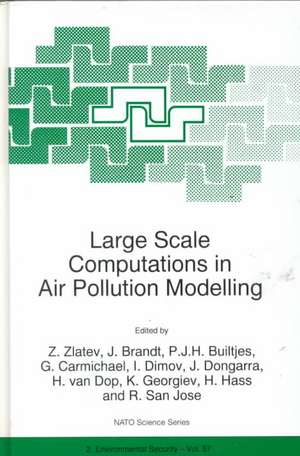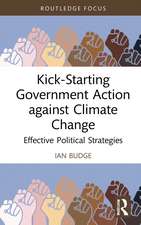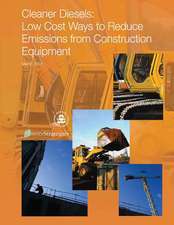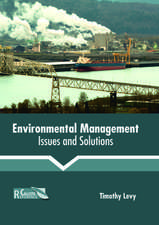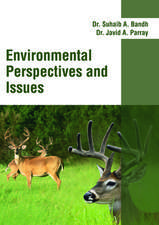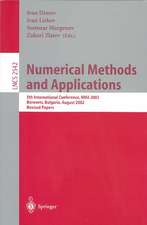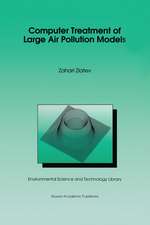Large Scale Computations in Air Pollution Modelling: NATO Science Series. Series 2, Environmental Security, cartea 57
Editat de Zahari Zlatev, Jorgen Brandt, Z. Zlateven Limba Engleză Hardback – 28 feb 1999
Preț: 590.12 lei
Preț vechi: 694.26 lei
-15% Nou
Puncte Express: 885
Preț estimativ în valută:
112.93€ • 117.47$ • 93.23£
112.93€ • 117.47$ • 93.23£
Carte tipărită la comandă
Livrare economică 14-28 aprilie
Preluare comenzi: 021 569.72.76
Specificații
ISBN-13: 9780792356776
ISBN-10: 0792356772
Pagini: 392
Dimensiuni: 160 x 240 mm
Greutate: 0.74 kg
Editura: Kluwer Academic Publishers
Seria NATO Science Series. Series 2, Environmental Security
Locul publicării:Dordrecht, Netherlands
ISBN-10: 0792356772
Pagini: 392
Dimensiuni: 160 x 240 mm
Greutate: 0.74 kg
Editura: Kluwer Academic Publishers
Seria NATO Science Series. Series 2, Environmental Security
Locul publicării:Dordrecht, Netherlands
Public țintă
ResearchCuprins
Preface. Acknowledgements. 1. Parallel algorithms for some optimization problems arising in air pollution modeling; J.L. Alonso, A.N. Alexandrov. 2. Modeling of global and regional transport and transformation of air pollutants; A.E. Aloyan. 3. Long-term calculations with large air pollution models; C. Ambelas, et al. 4. Parallel numerical simulation of air pollution in Southern Italy; G. Barone, et al. 5. Real time predictions of transport, dispersion and deposition from nuclear accidents; A. Bastrup-Birk, et al. 6. Mixing height in coastal areas - experimental results and modelling, A review; E. Batchvarova. 7. On some adaptive numerical methods for linear advection equations; R. Bochorishvili. 8. A parallel iterative scheme for solving the convection diffusion equation on distributed memory processors; L.A. Boukas, N.M. Missirlis. 9. Data Assimilation and HPCN-examples of the LOTOS model; P.J.H. Builtjes. 10. Computational challenges of modeling interactions between aerosol and gas phase processes in large scale air pollution models; G.R. Carmichael, et al. 11. ETEX: a European tracer experiment; observations, dispersion modelling and emergency response; H. van Dop, et al. 12. Parallel 4D-variational data assimilation for an Eulerian chemistry transport model; H. Elbern, et al. 13. Approaches for improving the numerical solution of the advection equation; M.V. Galperin. 14. Application of parallel algorithms in an air pollution model; K. Georgiev, Z. Zlatev. 15. Aerosol modelling within the EURAD Model System: Developments and applications; H. Hass, et al. 16. Calculation of ozone and other pollutants for summer 1996: The influence of lateral boundary concentrations on ozone levels'; J.E. Jonson, et al. 17. Atmospheric mechanisms of admixtures transfer; K.A. Karimov, R.D. Gainutdinova. 18. The varying scale modelling of air pollution transport; V.K. Kouznetsov, et al. 19. Deterioration on historic buildings due to air pollution and some difficulties during their restoration works; A.G. Kucukkaya. 20. Modelling of the long-term atmospheric transport of heavy metals over Plland; A Mazur. 21. Pollution transmission in the air; Cs. Mészáros, et al. 22. Bayesian heuristic approach (BHA) and applications to optimization of large scale discrete and continuous models; J. Mockus. 23. Nonlinear assignment problems; P.M. Pardalos, et al. 24. Some experiments in connection with neural and fuzzy modelling for air pollution problems; G.M. Sandulescu, M. Bistran. 25. Advanced operational air quality forecasting models for urban and regional environments in Europe: Madrid application; R. San José, et al. 26. Adaptive orthonormal systems; Bl. Sendov. 27. On some flux-type advection schemes for dispersion modelling application; D. Syrakov, M. Galperin. 28. A study of sulfur dioxide distribution over Ýstanbul, Turkey, and preliminary results of neural network analysis; M. Tayanç, A. Saral. 29. Krylov subspace methods for the solution of large systems of ODE's; P.G. Thomsen, N.H. Bjurstrøm. 30. The use of 3-D adaptive unstructured meshes in air pollution modeling; A.S. Tomlin, et al. 31. Atmospheric environmental management expert system for an oil-fired power plant; E.A. Unzalu. 33. A collaborative framework for air pollution simulations; E. Vavalis. 33. Including of surface source in a surface layer parameterization; D. Yordanov, D. Syrakov. 34. Conclusions of the NATO ARW on Large Scale Computations in Air Pollution Modelling; Z. Zlatev, et al. List of the participants. Subject index. Author index.
Recenzii
`... this book is a valuable addition to the issues and problems associated with large-scale computations in air pollution modelling. It is highly accessible in terms of how it is written, i.e. it is easy to read and should be a first choice as a starting point for reference material.' World Meteorological Organization Bulletin, 49:3 (2000)
